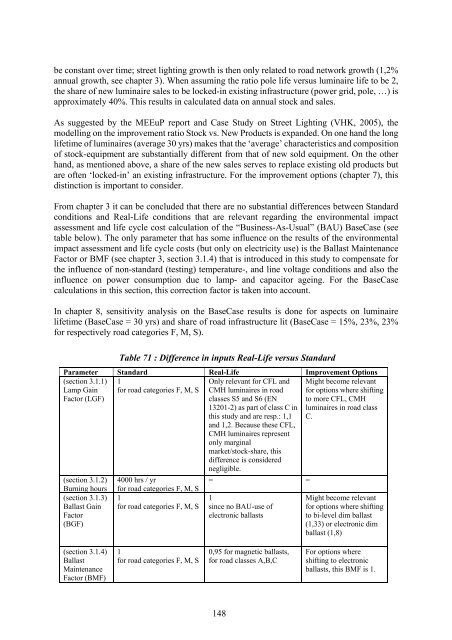Final Report Lot 9: Public street lighting - Amper
Final Report Lot 9: Public street lighting - Amper
Final Report Lot 9: Public street lighting - Amper
You also want an ePaper? Increase the reach of your titles
YUMPU automatically turns print PDFs into web optimized ePapers that Google loves.
e constant over time; <strong>street</strong> <strong>lighting</strong> growth is then only related to road network growth (1,2%<br />
annual growth, see chapter 3). When assuming the ratio pole life versus luminaire life to be 2,<br />
the share of new luminaire sales to be locked-in existing infrastructure (power grid, pole, …) is<br />
approximately 40%. This results in calculated data on annual stock and sales.<br />
As suggested by the MEEuP report and Case Study on Street Lighting (VHK, 2005), the<br />
modelling on the improvement ratio Stock vs. New Products is expanded. On one hand the long<br />
lifetime of luminaires (average 30 yrs) makes that the ‘average’ characteristics and composition<br />
of stock-equipment are substantially different from that of new sold equipment. On the other<br />
hand, as mentioned above, a share of the new sales serves to replace existing old products but<br />
are often ‘locked-in’ an existing infrastructure. For the improvement options (chapter 7), this<br />
distinction is important to consider.<br />
From chapter 3 it can be concluded that there are no substantial differences between Standard<br />
conditions and Real-Life conditions that are relevant regarding the environmental impact<br />
assessment and life cycle cost calculation of the “Business-As-Usual” (BAU) BaseCase (see<br />
table below). The only parameter that has some influence on the results of the environmental<br />
impact assessment and life cycle costs (but only on electricity use) is the Ballast Maintenance<br />
Factor or BMF (see chapter 3, section 3.1.4) that is introduced in this study to compensate for<br />
the influence of non-standard (testing) temperature-, and line voltage conditions and also the<br />
influence on power consumption due to lamp- and capacitor ageing. For the BaseCase<br />
calculations in this section, this correction factor is taken into account.<br />
In chapter 8, sensitivity analysis on the BaseCase results is done for aspects on luminaire<br />
lifetime (BaseCase = 30 yrs) and share of road infrastructure lit (BaseCase = 15%, 23%, 23%<br />
for respectively road categories F, M, S).<br />
Table 71 : Difference in inputs Real-Life versus Standard<br />
Parameter Standard Real-Life Improvement Options<br />
(section 3.1.1)<br />
Lamp Gain<br />
Factor (LGF)<br />
(section 3.1.2)<br />
Burning hours<br />
(section 3.1.3)<br />
Ballast Gain<br />
Factor<br />
(BGF)<br />
(section 3.1.4)<br />
Ballast<br />
Maintenance<br />
Factor (BMF)<br />
1<br />
for road categories F, M, S<br />
4000 hrs / yr<br />
for road categories F, M, S<br />
1<br />
for road categories F, M, S<br />
1<br />
for road categories F, M, S<br />
Only relevant for CFL and<br />
CMH luminaires in road<br />
classes S5 and S6 (EN<br />
13201-2) as part of class C in<br />
this study and are resp.: 1,1<br />
and 1,2. Because these CFL,<br />
CMH luminaires represent<br />
only marginal<br />
market/stock-share, this<br />
difference is considered<br />
negligible.<br />
= =<br />
1<br />
since no BAU-use of<br />
electronic ballasts<br />
0,95 for magnetic ballasts,<br />
for road classes A,B,C<br />
148<br />
Might become relevant<br />
for options where shifting<br />
to more CFL, CMH<br />
luminaires in road class<br />
C.<br />
Might become relevant<br />
for options where shifting<br />
to bi-level dim ballast<br />
(1,33) or electronic dim<br />
ballast (1,8)<br />
For options where<br />
shifting to electronic<br />
ballasts, this BMF is 1.
















